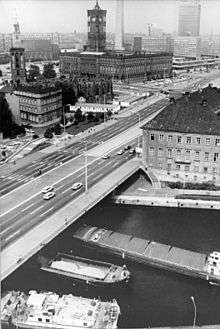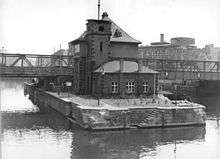Mühlendamm

Mühlendamm refers to the Mühlendammbrücke (Mill Dam Bridge) in East Berlin's Mitte district and the road crossing the Spree river between Gertaudenstraße and Molkenmarkt. Originally a dam was built at this location used for both crossing the river and for water mills. Later, after the installation of defenses, a lock enabled frequent changes in the crossing of the Spree. The current concrete bridge was built in 1968 and is part of the east–west road link to Berlin's city center.
History
Its earliest history was as a ford on the trading route between Teltow (in the direction of Halle and Wittenberg) and the Barnim (in the direction of Oderberg and Stettin) crossing the shallow river Spree. In the last third of the 12th century, this new Spree passage competed with existing crossings at Spandau and Köpenick. At the ford was a bridge that was plugged into a dam to generate water power for mills. This was the foundation of the village of Cölln and Alt-Berlin.
The first lock was built in 1578. The associated buildings functioned as a stock exchange until 1739. After several fires, buildings in the early 19th century were erected with sandstone colonnades. The street became a bustling commercial corridor. In 1888, a newly built 110-meter lock replaced the structures dating from the Middle Ages. The Spree river bed was deepened, and a bridge was added. The mills and related buildings were demolished in 1892.
Existing from 1850, a castle-like red and yellow brick building with castles and battlements became the seat of a municipal savings bank. Berliners called this the "Normal Castle," a name derived from a previously existing fort. Gottfried Keller, residing in Berlin from 1850 to 1955, wrote about the building in his poem, "Mühlenromantik:"
"But in Berlin, in the aroused aesthetic I saw brand new and in the best execution by the state-architect a massive Norman Festival. And it was a Flour-mill high and glorious, with battlements and towers Forming and roaring under the bridge The Berliners see the Spree storming"
The city leaders proposed a bridge as a viable steel structures. More bridges had to be constructed to cross over the channel and the lock chamber. The bridge was 15 meters wide with 8.5 meters of sidewalks, and the retention of the pedestrian bridge was 4.5 meters wide.
Between 1936 and 1940, the Mühlendamm was again redesigned, and the building and the defense disappeared envisioning a wider street. This included demolishing the Ephraim-Palais, considered "Berlin's finest corner." The outbreak of war prevented the completion of the renovations, which included two eleven-feet wide and 35-feet long steel trusses on both sides of the lock. In the last days of the war, the bridges were blown up by the Wehrmacht.

A temporary bridge was erected in 1946, and a provisional structure was restored using steel salvaged from the river. This bridge opened to traffic on September 1, 1946. In the 1960s, construction of a modern bridge was planned. The bridge was the largest East German road bridge at the time of its completion.
In preparation for the 750th anniversary of the city of Berlin in 1985, the rococo Ephraim-Palais was reconstructed twelve meters from its original location. For this, parts of the facade, which had been stored in West-Berlin, were delivered to East Berlin in 1982 to support the reconstruction.
Points of Interest
- Altes Stadthaus
- Neues Stadthaus
- Palais Schwerin
- Molkenmarkt
- Nikolaiviertel
- Gasthaus "Zur Rippe"
References
- The information in this article is based on that in its German equivalent.
Coordinates: 52°30′55″N 13°24′25″E / 52.51528°N 13.40694°E